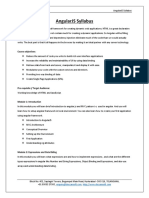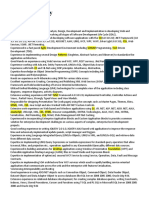0 ratings0% found this document useful (0 votes)
67 viewsAngular 2 Training Course Syllabus
The document outlines the syllabus for an Angular 2 training course. It covers topics such as getting started with Angular 2, creating and communicating between components, exploring the new template syntax, creating reusable services, routing and navigating pages, collecting data with forms and validation, dependency injection, directives and advanced components, communicating with servers, unit testing, and deploying applications to production.
Uploaded by
venkateshCopyright
© © All Rights Reserved
Available Formats
Download as PDF, TXT or read online on Scribd
0 ratings0% found this document useful (0 votes)
67 viewsAngular 2 Training Course Syllabus
The document outlines the syllabus for an Angular 2 training course. It covers topics such as getting started with Angular 2, creating and communicating between components, exploring the new template syntax, creating reusable services, routing and navigating pages, collecting data with forms and validation, dependency injection, directives and advanced components, communicating with servers, unit testing, and deploying applications to production.
Uploaded by
venkateshCopyright
© © All Rights Reserved
Available Formats
Download as PDF, TXT or read online on Scribd
You are on page 1/ 4
Angular 2 training Course Syllabus
Prerequisites for Angular 2 Course
HTML, CSS and JavaScript
Angular JS
Getting Started
Working with JavaScript Modules and SystemJs
Introduction to TypeScript
A Conceptual Overview of Angular 2
Here’s What We’ll Be Building
Installing Git and Node
Creating Your First Component
Using the Angular CLI
Creating and Communicating Between Components
Creating Your First Data-bound Component
Using External Templates
Communicating with Child Components Using @Input
Communicating with Parent Components Using @Output
Using Template Variables to Interact with Child Components
Styling Components
Exploring Angular’s CSS Encapsulation
Adding a Site Header
Exploring the New Template Syntax
Interpolation, Property Bindings, and Expressions
Event Bindings and Statements
Repeating Data with ngFor
Handling Null Values with the Safe-Navigation Operator
Hiding and Showing Content with ngIf
Hiding Content with the [Hidden] Binding
+91 89399 15577 contact@greenstechnologys.com
Hiding and Showing Content with ngSwitch
Styling Components with ngClass
Styling Components with ngStyle
Creating Reusable Services
Introduction
Why We Need Services and Dependency Injection
Creating Your First Service
Wrapping Third Party Services
Routing and Navigating Pages
Adding Multiple Pages to Your App
Adding Your First Route
Accessing Route Parameters
Linking to Routes
Navigating from Code
Guarding Against Route Activation
Guarding Against Route De-activation
Pre-loading Data for Components
Styling Active Links
Collecting Data with Forms and Validation
Introduction
Using Models for Type Safety
Creating Your First Template-based Form
Using the Data from Your Template-based Form
Validating Template-based Form
Validating Reactive Forms
Communicating Between Components
Passing Data into a Child Component
Passing Data out of a Child Component
Reusing Components with Content Projection
Content Projection
Multiple Slot Content Projection
Displaying Data with Pipes
Using Built-in Pipes
Creating a Custom Pipe
Sorting and Filtering Overview
Creating a Filtering Display
Filtering Data
Understanding Dependency Injection
Using Third Party Global Services – The Problem
Angular Dependency Injection Lookup
Using OpaqueToken for Dependency Injection
Using the @Inject Decorator
The useClass Provider
Creating Directives and Advanced Components
Implementing the Session Search
Adding jQuery
Creating a Modal Component
Fixing Template Parse Errors
Creating Directives – The Trigger Directive
Binding an ID
Routing to the Same Component
Using the @ViewChild Decorator
Creating Settings on Components
+91 89399 15577 contact@greenstechnologys.com
Communicating with the Server Using HTTP, Observables,
and Rx
Moving Data Storage to the Server
Listening to Resolved Data Changes
Using Querystring Parameters
Using POST and PUT
Using DELETE
Integrating Authentication with the Server
Persisting Authentication Status Across Page Refreshes
Saving User Data to the Server
Implementing Logout
Unit Testing Your Code
Installing Karma
Unit Testing Services
Testing Mock Calls
Testing Components with Isolated Tests
Going to Production
Learning the Concepts
Linting with TSLint
Tuning Your rxJS Requests
Enabling Production Mode
Basic Copy Deployment
Ahead of Time Compiler Overview
Preparing for the AOT Compiler
Making Coding Fixes for the AOT Compiler
Running the AOT Compiler
Tree Shaking and Bundling with Rollup
You might also like
- Innovations in Portland Cement Manufacturing80% (5)Innovations in Portland Cement Manufacturing1,283 pages
- MOC 20487B: Developing Windows Azure and Web Services Course OverviewNo ratings yetMOC 20487B: Developing Windows Azure and Web Services Course Overview9 pages
- Cognixia Course - Dot Net Full Stack - CrimsonLogicNo ratings yetCognixia Course - Dot Net Full Stack - CrimsonLogic34 pages
- Oracle Forms and Reports Training Course HighlightsNo ratings yetOracle Forms and Reports Training Course Highlights4 pages
- Kocer, John - Angular 9.x by Example (2020) - Libgen - LiNo ratings yetKocer, John - Angular 9.x by Example (2020) - Libgen - Li465 pages
- Oracle Forms Developer 10g: Build Internet Applications: Duration 5 DaysNo ratings yetOracle Forms Developer 10g: Build Internet Applications: Duration 5 Days4 pages
- Oracle Forms and Reports Training Course SyllabusNo ratings yetOracle Forms and Reports Training Course Syllabus4 pages
- Full-Stack Development Bootcamp: Industry Tested Courses CurriculumNo ratings yetFull-Stack Development Bootcamp: Industry Tested Courses Curriculum10 pages
- Developers Guide To Microsoft Enterprise Library 5 CSharp Edition Aug 2010 PDFNo ratings yetDevelopers Guide To Microsoft Enterprise Library 5 CSharp Edition Aug 2010 PDF273 pages
- Full Stack Developer: (Backend Specialization)No ratings yetFull Stack Developer: (Backend Specialization)21 pages
- 8580bf5e 586f 455b 9b04 D2477a6c6bbgfg7 - AngularJS - Syllabus - BestDotNetTrainingNo ratings yet8580bf5e 586f 455b 9b04 D2477a6c6bbgfg7 - AngularJS - Syllabus - BestDotNetTraining4 pages
- Advanced Perl Scripting Recommended Duration: 4 Days (32 Hours at 8 Hours Per Day)No ratings yetAdvanced Perl Scripting Recommended Duration: 4 Days (32 Hours at 8 Hours Per Day)13 pages
- Angular JS: Key Words: - Html5 Course DescriptionNo ratings yetAngular JS: Key Words: - Html5 Course Description7 pages
- Apache Wicket: Duration: 3 Days Course OutlineNo ratings yetApache Wicket: Duration: 3 Days Course Outline2 pages
- React - The Complete Guide (incl Hooks, React Router, Redux)No ratings yetReact - The Complete Guide (incl Hooks, React Router, Redux)8 pages
- Akhilesh Pandey: Javascript, Vbscript, XML, CSS, HTML, Browser Compatibility, DHTML Technologies, Ajax, XSLT, XML, XHTMLNo ratings yetAkhilesh Pandey: Javascript, Vbscript, XML, CSS, HTML, Browser Compatibility, DHTML Technologies, Ajax, XSLT, XML, XHTML8 pages
- CLC 12 - Capstone Draft Proposal WorksheetNo ratings yetCLC 12 - Capstone Draft Proposal Worksheet2 pages
- Wireless Energy Meter Reading Using RF Technology100% (1)Wireless Energy Meter Reading Using RF Technology26 pages
- The Institution of Engineers BangladeshiebNo ratings yetThe Institution of Engineers Bangladeshieb105 pages
- Pan Pearl River Delta Physics Olympiad 2014: V 10 M/s VNo ratings yetPan Pearl River Delta Physics Olympiad 2014: V 10 M/s V10 pages
- "Ask Me How": Stating Research QuestionNo ratings yet"Ask Me How": Stating Research Question16 pages
- Soalan Matematik Tambahan Kertas 1 SABAHNo ratings yetSoalan Matematik Tambahan Kertas 1 SABAH18 pages
- (Occasional Papers) Sujit Mukherjee - Towards A Literary History of India-Indian Institute of Advanced Study (1975)100% (1)(Occasional Papers) Sujit Mukherjee - Towards A Literary History of India-Indian Institute of Advanced Study (1975)112 pages
- Literary Genre On Creative Multimedia PresentationNo ratings yetLiterary Genre On Creative Multimedia Presentation21 pages
- Accountant Controller Finance Analyst in Lakeland FL Resume Fernando BertolliNo ratings yetAccountant Controller Finance Analyst in Lakeland FL Resume Fernando Bertolli3 pages
- Syllabus: Cambridge IGCSE (9-1) First Language English 0990No ratings yetSyllabus: Cambridge IGCSE (9-1) First Language English 099035 pages
- MOC 20487B: Developing Windows Azure and Web Services Course OverviewMOC 20487B: Developing Windows Azure and Web Services Course Overview
- Cognixia Course - Dot Net Full Stack - CrimsonLogicCognixia Course - Dot Net Full Stack - CrimsonLogic
- Oracle Forms and Reports Training Course HighlightsOracle Forms and Reports Training Course Highlights
- Kocer, John - Angular 9.x by Example (2020) - Libgen - LiKocer, John - Angular 9.x by Example (2020) - Libgen - Li
- Oracle Forms Developer 10g: Build Internet Applications: Duration 5 DaysOracle Forms Developer 10g: Build Internet Applications: Duration 5 Days
- Full-Stack Development Bootcamp: Industry Tested Courses CurriculumFull-Stack Development Bootcamp: Industry Tested Courses Curriculum
- Developers Guide To Microsoft Enterprise Library 5 CSharp Edition Aug 2010 PDFDevelopers Guide To Microsoft Enterprise Library 5 CSharp Edition Aug 2010 PDF
- 8580bf5e 586f 455b 9b04 D2477a6c6bbgfg7 - AngularJS - Syllabus - BestDotNetTraining8580bf5e 586f 455b 9b04 D2477a6c6bbgfg7 - AngularJS - Syllabus - BestDotNetTraining
- AngularJS Web Application Development BlueprintsFrom EverandAngularJS Web Application Development Blueprints
- Mastering JavaScript Single Page Application DevelopmentFrom EverandMastering JavaScript Single Page Application Development
- Advanced Perl Scripting Recommended Duration: 4 Days (32 Hours at 8 Hours Per Day)Advanced Perl Scripting Recommended Duration: 4 Days (32 Hours at 8 Hours Per Day)
- React - The Complete Guide (incl Hooks, React Router, Redux)React - The Complete Guide (incl Hooks, React Router, Redux)
- Akhilesh Pandey: Javascript, Vbscript, XML, CSS, HTML, Browser Compatibility, DHTML Technologies, Ajax, XSLT, XML, XHTMLAkhilesh Pandey: Javascript, Vbscript, XML, CSS, HTML, Browser Compatibility, DHTML Technologies, Ajax, XSLT, XML, XHTML
- Pan Pearl River Delta Physics Olympiad 2014: V 10 M/s VPan Pearl River Delta Physics Olympiad 2014: V 10 M/s V
- (Occasional Papers) Sujit Mukherjee - Towards A Literary History of India-Indian Institute of Advanced Study (1975)(Occasional Papers) Sujit Mukherjee - Towards A Literary History of India-Indian Institute of Advanced Study (1975)
- Literary Genre On Creative Multimedia PresentationLiterary Genre On Creative Multimedia Presentation
- Accountant Controller Finance Analyst in Lakeland FL Resume Fernando BertolliAccountant Controller Finance Analyst in Lakeland FL Resume Fernando Bertolli
- Syllabus: Cambridge IGCSE (9-1) First Language English 0990Syllabus: Cambridge IGCSE (9-1) First Language English 0990

























































































